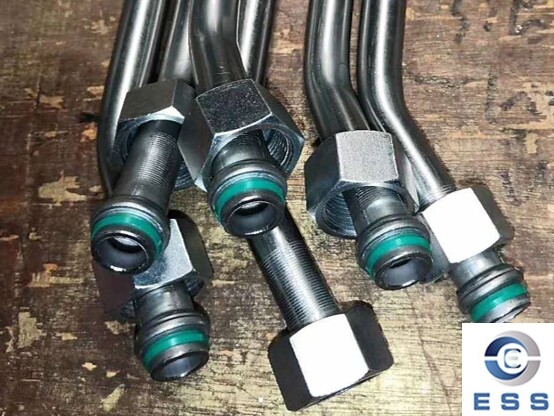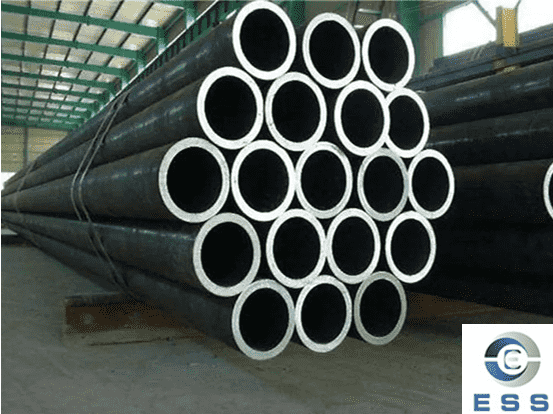The replacement cycle of hydraulic
tubes in hydraulic systems is not fixed, and it is usually recommended to
replace them every 3-5 years. However, the actual replacement time needs to be
comprehensively judged based on factors such as the frequency of use of the
hydraulic tube, the working environment, the quality of the material, and the
working pressure and flow of the system. In harsh working environments or when
used at high frequencies, more frequent inspections and replacements may be
required. So under what specific circumstances do hydraulic tubes need to be
replaced?

Appearance damage
1. Wear on the pipe surface
When the outer surface of the hydraulic
tube is obviously worn, such as long-term friction with other parts, causing
the rubber layer or the outer protective cover to become thinner, damaged, or
even exposing the internal reinforcement layer (such as the wire braid layer or
the winding layer), it needs to be replaced. For example, in some mechanical
equipment, hydraulic tubes may experience this kind of wear due to the
vibration of the equipment or frequent contact with the surrounding metal
structure. Because once the outer protective structure is damaged, the internal
hydraulic tube structure is easily eroded by the external environment, such as
moisture, dust, etc., which in turn affects the performance and service life of
the hydraulic tube.
2. Bulge and crack phenomenon
If there are bulges or cracks on the
surface of the hydraulic tube, this is a serious problem. Bulge may be caused
by excessive internal pressure, separation between the rubber layer and the
reinforcement layer, or aging of the material. Cracks may be caused by
excessive bending and stretching of the pipe, or long-term exposure to harsh
environmental conditions (such as low temperature causing the material to
become brittle). Whether it is bulge or crack, the strength of the hydraulic
tube will decrease and the risk of bursting will increase, so it should be
replaced immediately once it is found.
Leakage problem
1. Oil leakage at the joint
Oil leakage at the joint of the hydraulic
tube is a common problem. This may be due to damage to the joint seal, loose
joint or damage to the pipe end. If the oil leakage problem cannot be solved by
simple measures such as tightening the joint nut, it is necessary to further
check the hydraulic tube and joint. If it is found that it is a problem with
the hydraulic tube itself, such as deformation of the pipe end, damage to the
inner rubber layer, etc., which makes it impossible to form a good seal, then
the hydraulic tube needs to be replaced.
2. Pipe body leakage
When the hydraulic tube body leaks, it
indicates that the pipe has been seriously damaged. Leakage may be caused by
the pipe being scratched, corroded and perforated, or the pipe wall being
broken due to excessive internal pressure. In this case, the hydraulic tube can
no longer work properly and must be replaced immediately to avoid a large
amount of hydraulic oil leakage, affecting the normal operation of the
hydraulic system, and also preventing environmental pollution and safety
hazards caused by hydraulic oil leakage.
Performance degradation
1. Excessive pressure loss
During the normal operation of the
hydraulic system, if the pressure difference between the two ends of the
hydraulic tube is found to be significantly increased and exceeds the normal
range, this may be caused by internal blockage of the hydraulic tube, smaller
pipe diameter (such as expansion or shedding of the inner rubber layer), or the
pipe is too long and bent too much. Excessive pressure loss will affect the
working efficiency of the hydraulic system and prevent the actuator from
obtaining sufficient power. If it is determined after inspection that the
pressure loss is too large due to the problem of the hydraulic tube itself, and
it cannot be solved by cleaning, unblocking, etc., the hydraulic tube needs to
be replaced.
2. Insufficient flow
When the hydraulic system has insufficient
flow and the failure of other hydraulic components such as pumps and valves is
excluded, it may be a problem with the hydraulic tube. For example, the inner
diameter of the hydraulic tube becomes smaller due to deformation, blockage,
etc., which will limit the flow of hydraulic oil. In this case, it is necessary
to determine whether to replace the hydraulic tube according to the actual
situation. If it is a local blockage, you can try to clean it, but if the inner
diameter becomes smaller or deforms seriously due to the quality problem of the
pipe itself, it needs to be replaced.
Aging factors
1. Material aging
The material of the hydraulic tube will age
with time and the use environment. For example, when a rubber hydraulic tube is
exposed to high temperature, ultraviolet radiation, chemical erosion, etc. for
a long time, the rubber will become hard, brittle or soft and lose elasticity.
This change in material properties will cause the pressure resistance and
fatigue resistance of the hydraulic tube to decrease. Generally speaking, the
service life of a rubber hydraulic tube is about 3-5 years, and the specific time
will also be affected by the use environment and working conditions. When it is
found that the hydraulic tube material is obviously aged, in order to ensure
the safety and normal operation of the hydraulic system, the hydraulic tube
should be replaced.
2. Aging after long-term idleness
If the hydraulic tube is idle for a long
time, it may age due to environmental factors even if it is not actually
working. For example, if it is placed in a humid environment with corrosive
gases, the hydraulic tube may suffer from corrosion and aging of the rubber
layer. Before reactivating the hydraulic system, the hydraulic tube should be
inspected and replaced if there are serious signs of aging.
Frequent failures or many maintenance
records
If the hydraulic tube has frequent minor
failures over a period of time, such as multiple minor leaks, local damage that
has been repaired and then quickly recurred, this indicates that the overall
performance of the hydraulic tube has declined and its reliability has decreased.
At this time, from the perspective of long-term considerations and ensuring the
stable operation of the hydraulic system, it is recommended to replace the
hydraulic tube even if the current failure seems to be repairable. Because
frequent maintenance not only increases costs and downtime, but also poses
potential safety hazards.
Summary
Whether the hydraulic tube needs to be
replaced is mainly based on the appearance inspection, performance testing, and
abnormal conditions during use of the hydraulic tube. For example, if the
hydraulic tube is found to be cracked, deformed, severely worn or leaking, it
should be replaced with a new one in time. In addition, the hydraulic system
should be tested regularly for performance. If the hydraulic tube performance
is found to be degraded or cannot meet the system requirements, it should also
be considered for replacement. Regular replacement of hydraulic tubes is very
important for hydraulic systems, which can avoid losses caused by hydraulic
tube failures and improve work efficiency.













 Eastern Steel Manufacturing Co.,Ltd not only improve product production and sales services, but also provide additional value-added services. As long as you need, we can complete your specific needs together.
Eastern Steel Manufacturing Co.,Ltd not only improve product production and sales services, but also provide additional value-added services. As long as you need, we can complete your specific needs together.










